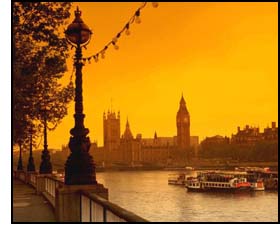I
L
O
V
E
U
|
|
United Kingdom
|

|
|
|
|
|

|
|
|
|
|
Country Statistics
|
 Land area:
Land area: 93,278 sq mi (241,590 sq km);
total area: 94,526 sq mi (244,820 sq km)
Population (2006): 60,609,153 (growth rate: 0.3%); birth rate: 10.7/1000; infant mortality rate:5.1/1000; life expectancy: 78.5; density per sq mi: 650
Capital City: London
Monetary unit: Pound sterling (£)
Languages: English, Welsh, Scots Gaelic
Ethnicity/race: English 81.5%; Scottish 9.6%; Irish 2.4%; Welsh 1.9%; Ulster 1.8%; West Indian, Indian, Pakistani, and other 2.8%
Religions: Anglican and Roman Catholic 40 million, Muslim 1.5 million, Presbyterian 800,000, Methodist 760,000, Sikh 500,000, Hindu 500,000, Jewish 350,000
|
|
|

|
|
|
|
Country Introduction
|

The United Kingdom consists of Great Britain (England, Scotland and Wales), plus the six counties of Northern Ireland. The Isle of Man and the Channel Islands (principally Jersey and Guernsey) are also parts of the British Isles, but not officially part of the UK.
Most of England consists of rolling lowland terrain, divided east from west by more mountainous terrain in the Northwest and north and limestone hills of the Peak District by the Tees-Exe line. The main rivers and estuaries are the Thames, Severn and the Humber Estuary. The largest urban area is Greater London. Near Dover, the Channel Tunnel links the United Kingdom with France.
Scotland's geography is varied, with lowlands in the south and east and highlands in the north and west, including Ben Nevis, the highest mountain in the British Isles at 1,344 metres (4,408 ft). There are many long and deep-sea arms, firths, and lochs. Scotland has nearly 800 islands, mainly west and north of the mainland, notably the Hebrides, Orkney Islands and Shetland Islands. The capital city is Edinburgh, the centre of which is a World Heritage Site. The largest city is Glasgow.
Wales is mostly mountainous, the highest peak being Snowdon at 1,085 metres (3,560 ft) above sea level. North of the mainland is the island of Anglesey. The largest and capital city is Cardiff, located in South Wales.
|
|
|

|
|
|
|
The Culture
|

Despite its relatively small size, the United Kingdom is one of the most culturally diverse countries on Earth, peopled by four main ‘native’ nationalities, plus later arrivals from all over the world.
It is a European state, and has many cultural links with its former colonies, particularly those that use the English language (the Anglosphere). Considerable contributions to British culture have been made over the last half-century by immigrants from the Indian Subcontinent and the West Indies. The origins of the UK as a political union of formerly independent states has resulted in the preservation of distinctive cultures in each of the home nations.
The United Kingdom contains two of the world's most famous universities, the University of Cambridge and the University of Oxford, and has produced many great scientists and engineers including Isaac Newton, James Watt, Charles Darwin, and Isambard Kingdom Brunel. A great number of world-changing inventions or discoveries were made by British people, including: Michael Faraday, Frank Whittle, Charles Babbage, Robert Baden-Powell, Alexander Fleming, John Logie Baird, William Caxton, Richard Trevithick, Humphry Davy, Robert Watson-Watt, Henry Bessemer, Tim Berners-Lee and others
Also, a great number of the world's major sports originated in the United Kingdom, including: football, golf, boxing, rugby, cricket, snooker, billiards, badminton and curling.
United Kingdon is also home to playwright William Shakespeare, arguably the most famous writer in the world.
|
|
|

|
|
|
|
Architecture & Landmarks
|

London is a British attraction for overseas visitors, with its historic landmarks such as Parliament, Buckingham Palace, Westminster Abbey, St. Paul’s Cathedral and the Tower of London. They also flock to the many West End theatres and the shopping areas of Knightsbridge, Oxford Street and Regent Street.
Within easy day-trip distance of London are the university cities of Oxford and Cambridge, the picturesque Cotswolds with their many pretty villages, Stratford-upon-Avon (home of William Shakespeare), the cathedral at Canterbury and the seaside attractions of Brighton.
Further afield lie delights like Cornwall (to the southwest), Yorkshire, Durham, Northumberland and Cumbria (a large part of which constitutes the Lake District). Wales adjoins England to the west, and offers, in addition to its populous southern cities, a diverse range of historic castles, spectacular coastlines and impressive mountain landscapes.
|
|
|

|
|
N
U
S
R
A
T
|
|
|